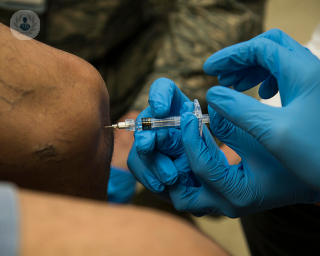What is joint pain?
Joint pain refers to pain, discomfort and soreness in the joints. Joints are the parts of your body where bones meet. They allow your bones to move. Joints include the shoulders, elbows, hips and knees. Joint pain can be the result of damage that occurs through normal wear and tear or be a sign of an infection or an underlying condition such as rheumatoid arthritis.
What are the symptoms of joint pain?
Symptoms of joint pain include:
- Swelling, redness and tenderness around the joint
- Pain persisting for three days or longer
- Fever symptoms without the flu
You should seek emergency care if the following symptoms are present:
- Joint deformity
- Swelling that occurs suddenly without reason
- If you’ve had an injury or fall
- You can’t move your joint
- You have extreme pain
How is joint pain diagnosed?
Your doctor performs a physical exam. A joint X-ray may be carried out to look at the joint damage. A blood test may be performed to detect if there is an autoimmune disorder.
What causes joint pain?
Joint pain is usually caused by diseases such as osteoarthritis and rheumatoid arthritis, and sometimes it’s caused by an illness or an injury. Osteoarthritis is one of the most common causes of joint pain and is mostly found among adults over the age of 40. Osteoarthritis affects the wrists, hands, hips and knees. The disease results from the breakdown of cartilage which acts a shock absorber and cushions joints.
Rheumatoid arthritis affects more women than and causes pain, inflammation and a build-up of fluid in the joints because the body’s immune system is attacking itself.
Other causes of joint pain include:
- Lupus
- Gout
- Bursitis
- Infectious diseases such as mumps, influenza and hepatitis
- Chondromalacia of the kneecap
- Tendinitis
- Overusing joints
- Cancer
- Rickets
- Osteoporosis
- Fibromyalgia
- Sarcoidosis
How can joint pain be treated?
Treatment will depend on the cause of the pain. Fluid may need to be removed from joints to test for infection or other causes of joint pain. In some instance surgery to replace the joint may be necessary. There’s no treatment currently available to treat osteoarthritis and rheumatoid arthritis, but the pain caused by these conditions can be managed with:
- Topical pain relievers
- Nonsteroidal anti-inflammatory drugs to reduce pain, swelling and inflammation
- Moderate exercise
- Stretching to keep joints mobile and flexible
- Maintaining a healthy weight, as this puts less pressure on your joints
- Getting adequate rest
- Taking a warm bath or having a massage can also help
Joint pain
What is joint pain?
Joint pain refers to pain, discomfort and soreness in the joints. Joints are the parts of your body where bones meet. They allow your bones to move. Joints include the shoulders, elbows, hips and knees. Joint pain can be the result of damage that occurs through normal wear and tear or be a sign of an infection or an underlying condition such as rheumatoid arthritis.
What are the symptoms of joint pain?
Symptoms of joint pain include:
- Swelling, redness and tenderness around the joint
- Pain persisting for three days or longer
- Fever symptoms without the flu
You should seek emergency care if the following symptoms are present:
- Joint deformity
- Swelling that occurs suddenly without reason
- If you’ve had an injury or fall
- You can’t move your joint
- You have extreme pain
How is joint pain diagnosed?
Your doctor performs a physical exam. A joint X-ray may be carried out to look at the joint damage. A blood test may be performed to detect if there is an autoimmune disorder.
What causes joint pain?
Joint pain is usually caused by diseases such as osteoarthritis and rheumatoid arthritis, and sometimes it’s caused by an illness or an injury. Osteoarthritis is one of the most common causes of joint pain and is mostly found among adults over the age of 40. Osteoarthritis affects the wrists, hands, hips and knees. The disease results from the breakdown of cartilage which acts a shock absorber and cushions joints.
Rheumatoid arthritis affects more women than and causes pain, inflammation and a build-up of fluid in the joints because the body’s immune system is attacking itself.
Other causes of joint pain include:
- Lupus
- Gout
- Bursitis
- Infectious diseases such as mumps, influenza and hepatitis
- Chondromalacia of the kneecap
- Tendinitis
- Overusing joints
- Cancer
- Rickets
- Osteoporosis
- Fibromyalgia
- Sarcoidosis
How can joint pain be treated?
Treatment will depend on the cause of the pain. Fluid may need to be removed from joints to test for infection or other causes of joint pain. In some instance surgery to replace the joint may be necessary. There’s no treatment currently available to treat osteoarthritis and rheumatoid arthritis, but the pain caused by these conditions can be managed with:
- Topical pain relievers
- Nonsteroidal anti-inflammatory drugs to reduce pain, swelling and inflammation
- Moderate exercise
- Stretching to keep joints mobile and flexible
- Maintaining a healthy weight, as this puts less pressure on your joints
- Getting adequate rest
- Taking a warm bath or having a massage can also help


Lipogems Q&A with Dr Ralph Rogers, the UK pioneer of Lipogems
Por Dr Ralph Rogers
2024-12-29
Learn from Dr Rogers about the benefits of Lipogems, a procedure of fat-assisted healing and an incredible way of relieving joint pain and postponing or avoiding surgery altogether. подробнее


Rheumatoid arthritis: Which lifestyle changes are recommended to help manage the condition?
Por Professor Tom Sheeran
2024-12-29
Highly esteemed consultant rheumatologist Professor Tom Sheeran gives an expert guide to the advances in treatment of rheumatoid arthritis and reveals the most impactful lifestyle changes patients can make to help manage their condition. подробнее


Sacroiliac joint dysfunction and its role in lower back pain
Por Mr Prokopios Annis
2024-12-29
If you have been struggling with pain in your lower back or upper thighs, this may be indicative of sacroiliac joint dysfunction (SIJD) – however, it is a condition that is often misdiagnosed. The two sacroiliac joints connect the spine to the pelvis, and dysfunction or inflammation can occur in one or both joints. In this guide, Mr Prokopios Annis, an experienced spinal surgeon, clearly explains what SIJD is so that patients can understand this condition and how to manage the symptoms. подробнее


Lipogems and osteoarthritis: a patient guide
Por Dr Ralph Rogers
2024-12-29
One of the latest advances in regenerative medicine, Lipogems injections, is now available at an increasing number of clinics across the UK, promising a new way to treat osteoarthritis without surgery. In this article, leading sports medicine specialist Dr Ralph Rogers has written a patient guide to Lipogems, covering how it works, who it’s suitable for, and how long the results last. подробнее
Врачи-специалисты в области Боли в суставах

Midland Health Birmingham
Midland Health Birmingham
Midland Health, 23a Highfield Road
No existe teléfono en el centro.
Si haces uso de este teléfono facilitado por TOP DOCTORS nos autorizas al tratamiento de tu teléfono para fines estadísticos y comerciales. Para más información, lee nuestra Политика конфиденциальности
Top Doctors

OS Clinic
OS Clinic
OS Clinic, 45 Queen Anne St, London W1G 9JF
No existe teléfono en el centro.
Si haces uso de este teléfono facilitado por TOP DOCTORS nos autorizas al tratamiento de tu teléfono para fines estadísticos y comerciales. Para más información, lee nuestra Политика конфиденциальности
Top Doctors

The Alexandra Hospital - part of Circle Health Group
The Alexandra Hospital - part of Circle Health Group
Mill Ln, Cheadle, SK8 2PX
No existe teléfono en el centro.
Si haces uso de este teléfono facilitado por TOP DOCTORS nos autorizas al tratamiento de tu teléfono para fines estadísticos y comerciales. Para más información, lee nuestra Политика конфиденциальности
Top Doctors
-
Midland Health Birmingham
Midland Health, 23a Highfield Road, EdgbastonЭксперт в области :
- Диагностика при помощи визуализации
- беременность
- Женское здоровье
- Семейная медицина
- Менопауза
- Сексуальное здоровье
-
OS Clinic
OS Clinic, 45 Queen Anne St, London W1G 9JF, W1G Marylebone LondonЭксперт в области :
- тазобедренный
- Операция с минимальным доступом (операция с замочной скважиной)
- Совместная операция по сохранению
- Челюстно-лицевая хирургия
- ортопедическая хирургия
- Ортопедическая хирургия позвоночника
-
The Alexandra Hospital - part of Circle Health Group
Mill Ln, Cheadle, SK8 2PX, CheadleЭксперт в области :
- тазобедренный
- Кардиология
- Плечо и локоть
- Педиатрия
- Нога и лодыжка
- коленный
- See more







